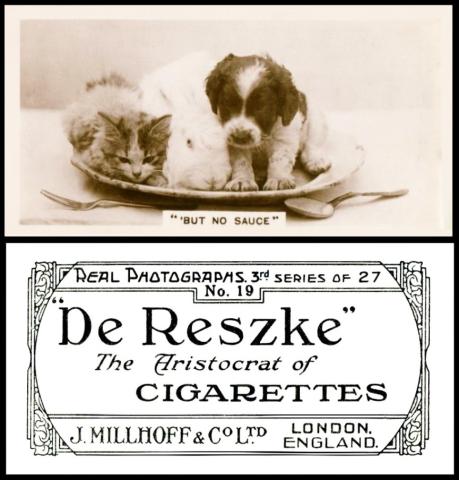
Now the reason for this card is another curry conundrum, because in actual fact the Tamil word `Kari` does not technically mean the entire dish, it means the sauce, which is seasoned with assorted spices.
Now as we have discovered, the first British mention of `currey` is said to be in 1747. But the first place serving the meal was actually in the 1730s - and it was a coffee house, the Norris Street one, near the Haymarket. Then it took ten more years for the first curry powder to be sold to members of the general public. This blend of spices was nothing like the way the original dish was seasoned, and also took no account of the fact that all the Indian versions differed, on a regional basis, using native plants and ingredients.
And there turns out to be a surprising link between one of our previous cards and the card we have selected for tomorrow!
Now Millhoff has a rather interesting story. They were founded in 1883, as Drapkin & Millhoff, though the cards did not carry that name, only a brand, "Eldona". This is why one of their sets is called "Beauties KEWA", for the reference books freely admit that they are using the E from Eldona.
In 1899 they broke up, becoming Millhoff and Major Drapkin. Despite this Drapkin & Millhoff combined cards were still circulating in 1900. One of those brands was "Pick-Me-Up" cigarettes, and there seems to have been some kind of promotional deal going on because the printing on these include many references to London theatres and places of interest, where they were presumably sold, perhaps in vending machines. Oddly to modern sensibilities, one of these was St. Bartholomew`s Hospital.
After the split into two companies, Millhoff continued this cross promotion, issuing large and medium sized cards to advertise "The Messenger Boy" which was then playing at theatres. These seem to have gone on until 1905, though not that many different cards are known.
At some time both Millhoff and Drapkin came together again, both being bought up by United Kingdom Tobacco. It is from this time that most of the Millhoff cards were issued. And in January 1926 Millhoff was bought by Godfrey Phillips, who started the "De Rezske" brand in May of the same year.
Our set is described in our original World Tobacco Issues Indexes as :
REAL PHOTOGRAPHS. Sm. 67 x 35. Sepia photos. Nd. See Ha.538 (or RB.113/7 in the updated W.T.I.I.)
1. "A Series of 27". Front (a) matt (b) glossy
2. "2nd Series of 27".
3. "3rd Series of 27".
4. "4th Series of 27".
5. "5th Series of 27".
6. "6th Series of 27".
Ha.538 adds another layer to the story of this set by announcing that it was also issued by Cavanders in 1936 as a thirty-six card set, entitled "Animal Studies" (which we used in our newsletter on Monday the 3rd of October 2022) and by Godfrey Phillips in 1930 as a set of fifty cards, but without any title - however that is usually listed in catalogues as "Animal Studies - Australia". It is stated that both these sets were made up of cards selected from our six series, but that seems to make the Godfrey Phillips date wrong, because that is quoted as having been issued in 1930 and our sets only started in 1931.
However in our original Godfrey Phillips reference book (RB.13) the entry for this set reads :
7. 50 ANIMAL STUDIES (adopted title). Small cards, size 67 x 35 m/m. Fronts printed by letterpress in sepia, glazed. Backs per Fig.16 in black. Subjects seen are similar to cards by Millhoff ("Real Photographs") and Cavander ("Animal Studies") Issued ?1933 in Australia.
And the date of 1933 supports the fact that our cards were indeed first.
